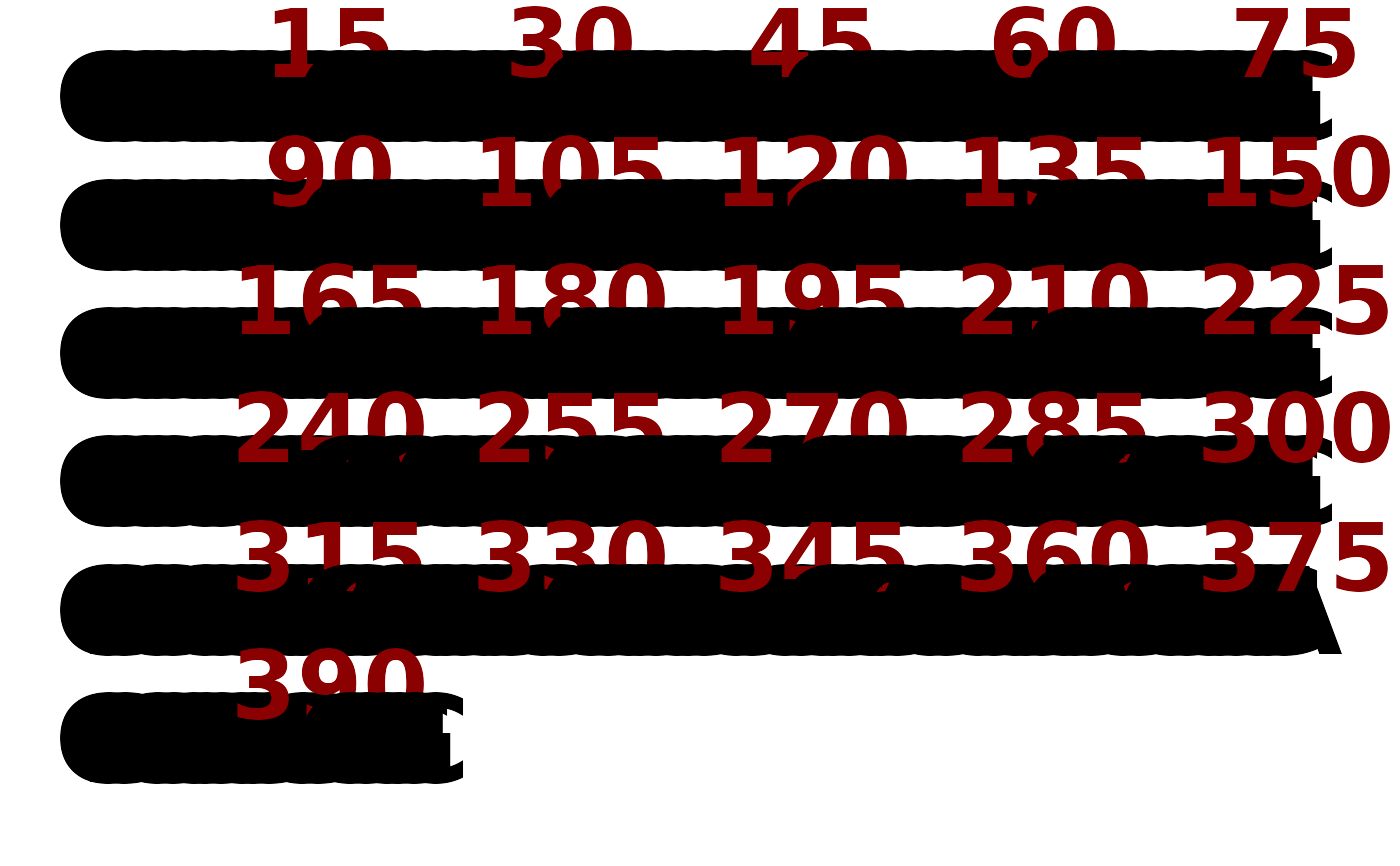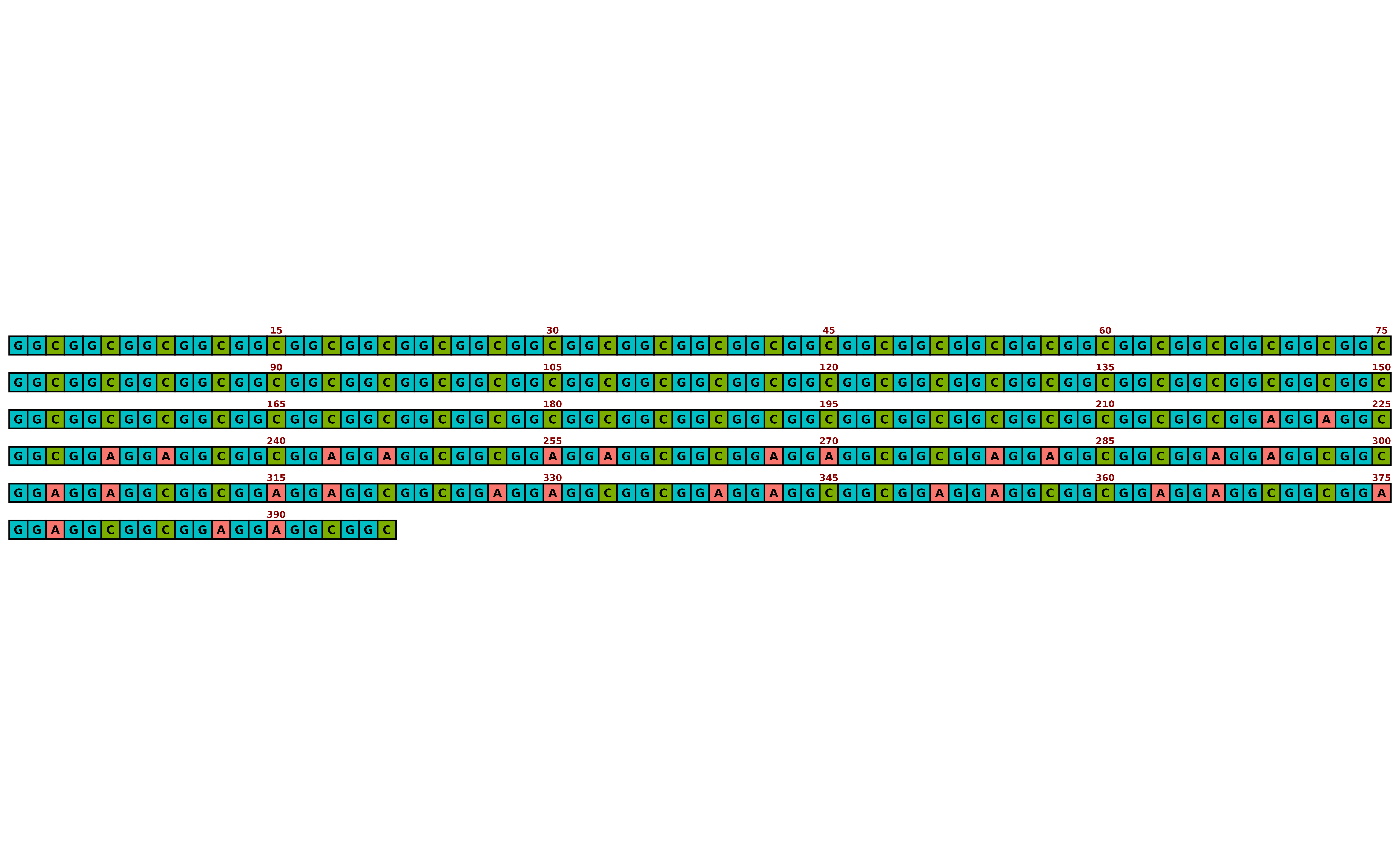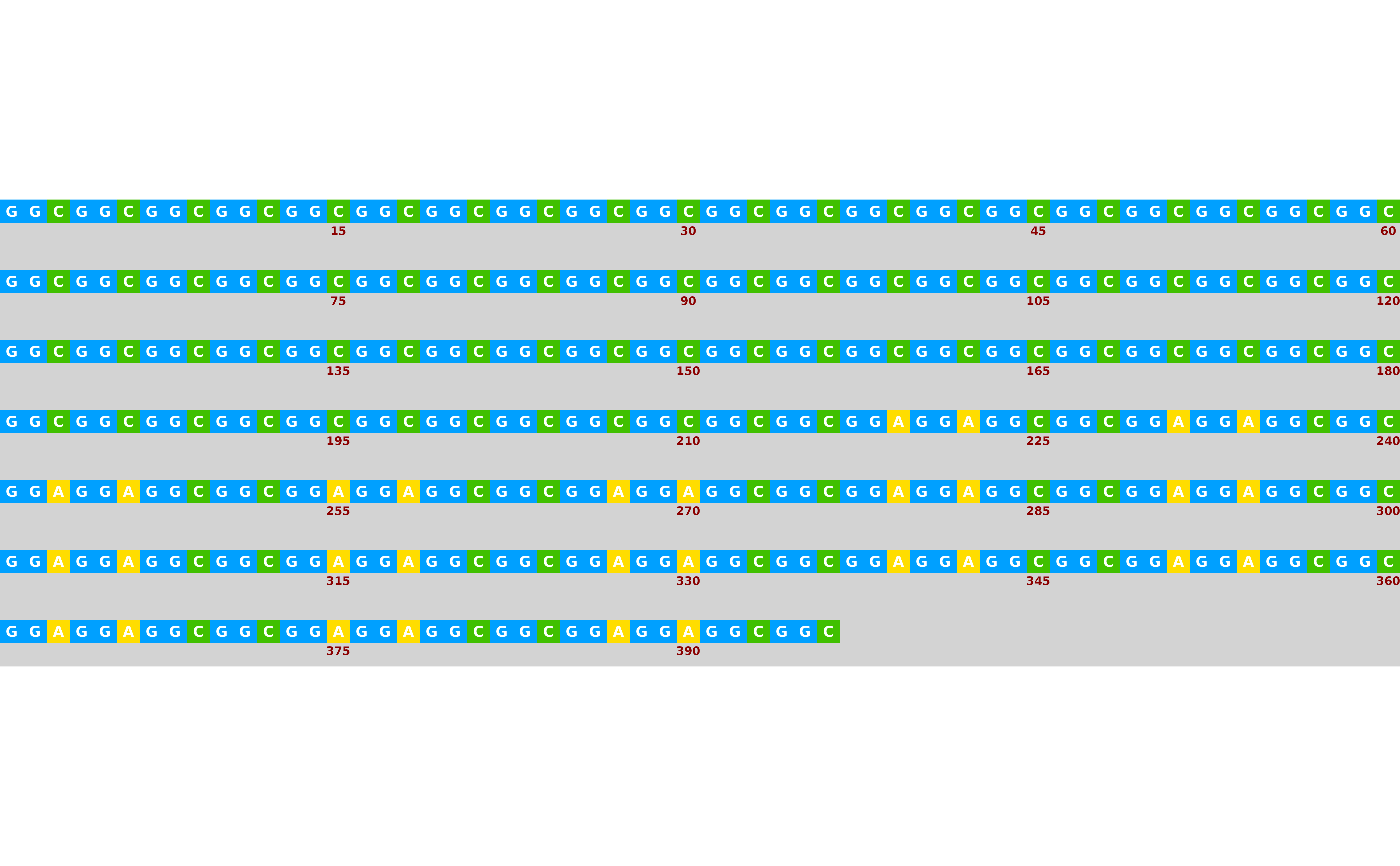
Visualise a single DNA/RNA sequence
Source:R/visualise_single_sequence.R
visualise_single_sequence.RdThis function takes a DNA/RNA sequence and returns a ggplot visualising it, with the option to directly export a png image with appropriate dimensions. Colours, line wrapping, index annotation interval, and pixels per square when exported are configurable.
Usage
visualise_single_sequence(
sequence,
sequence_colours = sequence_colour_palettes$ggplot_style,
background_colour = "white",
line_wrapping = 75,
spacing = 1,
margin = 0.5,
sequence_text_colour = "black",
sequence_text_size = 16,
index_annotation_colour = "darkred",
index_annotation_size = 12.5,
index_annotation_interval = 15,
index_annotations_above = TRUE,
index_annotation_vertical_position = 1/3,
outline_colour = "black",
outline_linewidth = 3,
outline_join = "mitre",
return = TRUE,
filename = NA,
render_device = ragg::agg_png,
pixels_per_base = 100
)Arguments
- sequence
character. A DNA or RNA sequence to visualise e.g."AAATGCTGC".- sequence_colours
character vector, length 4. A vector indicating which colours should be used for each base. In order:c(A_colour, C_colour, G_colour, T/U_colour).
Defaults to red, green, blue, purple in the default shades produced by ggplot with 4 colours, i.e.c("#F8766D", "#7CAE00", "#00BFC4", "#C77CFF"), accessed viasequence_colour_palettes$ggplot_style.- background_colour
character. The colour of the background. Defaults to white.- line_wrapping
integer. The number of bases that should be on each line before wrapping. Defaults to75. Recommended to make this a multiple of the repeat unit size (e.g. 3n for a trinucleotide repeat) if visualising a repeat sequence.- spacing
integer. The number of blank lines between each line of sequence. Defaults to1.
Be careful when setting to0as this means annotations have no space so might render strangely. Recommended to setindex_annotation_interval = 0if doing so to disable annotations entirely.- margin
numeric. The size of the margin relative to the size of each base square. Defaults to0.5(half the side length of each base square).
Note that if index annotations are on (i.e.index_annotation_intervalis not0), the top/bottom margin (depending onindex_annotations_above) will always be at least 1 to leave space for them.
Likewise, very small margins (\(\le\)0.25) may cause thick outlines to be cut off at the edges of the plot. Recommended to either use a wider margin or a smalleroutline_linewidth.- sequence_text_colour
character. The colour of the text within the bases (e.g. colour of "A" letter within boxes representing adenosine bases). Defaults to black.- sequence_text_size
numeric. The size of the text within the bases (e.g. size of "A" letter within boxes representing adenosine bases). Defaults to16. Set to0to hide sequence text (show box colours only).- index_annotation_colour
character. The colour of the little numbers underneath indicating base index (e.g. colour "15" label under the 15th base). Defaults to dark red.- index_annotation_size
numeric. The size of the little number underneath indicating base index (e.g. size of "15" label under the 15th base). Defaults to12.5.
Can sometimes be set to0to turn off annotations, but it is better/more reliable to do this viaindex_annotation_interval = 0.- index_annotation_interval
integer. The frequency at which numbers should be placed underneath indicating base index, starting counting from the leftmost base in each row. Defaults to15(every 15 bases along each row).
Recommended to make this a factor/divisor of the line wrapping length (meaning the final base in each line is annotated), otherwise the numbering interval resetting at the beginning of each row will result in uneven intervals at each line break.
Set to0to turn off annotations (preferable over usingindex_annotation_size = 0).- index_annotations_above
logical. Whether index annotations should go above (TRUE, default) or below (FALSE) each line of sequence.- index_annotation_vertical_position
numeric. How far annotation numbers should be rendered above (ifindex_annotations_above = TRUE) or below (ifindex_annotations_above = FALSE) each base. Defaults to1/3.
Not recommended to change at all. Strongly discouraged to set below 0 or above 1.- outline_colour
character. The colour of the box outlines. Defaults to black.- outline_linewidth
numeric. The linewidth of the box outlines. Defaults to3. Set to0to disable box outlines.- outline_join
character. One of"mitre","round", or"bevel"specifying how outlines should be joined at the corners of boxes. Defaults to"mitre". It would be unusual to need to change this.- return
logical. Boolean specifying whether this function should return the ggplot object, otherwise it will returninvisible(NULL). Defaults toTRUE.- filename
character. Filename to which output should be saved. If set toNA(default), no file will be saved. Recommended to end with".png", but can change if render device is changed.- render_device
function/character. Device to use when rendering. Seeggplot2::ggsave()documentation for options. Defaults toragg::agg_png. Can be set toNULLto infer from file extension, but results may vary between systems.- pixels_per_base
integer. How large each box should be in pixels, if file output is turned on via settingfilename. Corresponds to dpi of the exported image. Large values recommended because text needs to be legible when rendered significantly smaller than a box. Defaults to100.
Value
A ggplot object containing the full visualisation, or invisible(NULL) if return = FALSE. It is often more useful to use filename = "myfilename.png", because then the visualisation is exported at the correct aspect ratio.
Examples
# \donttest{
## Create sequence to visualise
sequence <- paste(c(rep("GGC", 72), rep("GGAGGAGGCGGC", 15)), collapse = "")
## Visualise with all defaults
## This looks ugly because it isn't at the right scale/aspect ratio
visualise_single_sequence(sequence)
 ## Export with all defaults rather than returning
visualise_single_sequence(
sequence,
filename = "example_vss_01.png",
return = FALSE
)
## View exported image
image <- png::readPNG("example_vss_01.png")
unlink("example_vss_01.png")
grid::grid.newpage()
grid::grid.raster(image)
## Export with all defaults rather than returning
visualise_single_sequence(
sequence,
filename = "example_vss_01.png",
return = FALSE
)
## View exported image
image <- png::readPNG("example_vss_01.png")
unlink("example_vss_01.png")
grid::grid.newpage()
grid::grid.raster(image)
 ## Export while customising appearance
visualise_single_sequence(
sequence,
filename = "example_vss_02.png",
return = FALSE,
sequence_colours = sequence_colour_palettes$bright_pale,
sequence_text_colour = "white",
background_colour = "lightgrey",
line_wrapping = 60,
spacing = 2,
outline_linewidth = 0,
index_annotations_above = FALSE,
margin = 0
)
## View exported image
image <- png::readPNG("example_vss_02.png")
unlink("example_vss_02.png")
grid::grid.newpage()
grid::grid.raster(image)
## Export while customising appearance
visualise_single_sequence(
sequence,
filename = "example_vss_02.png",
return = FALSE,
sequence_colours = sequence_colour_palettes$bright_pale,
sequence_text_colour = "white",
background_colour = "lightgrey",
line_wrapping = 60,
spacing = 2,
outline_linewidth = 0,
index_annotations_above = FALSE,
margin = 0
)
## View exported image
image <- png::readPNG("example_vss_02.png")
unlink("example_vss_02.png")
grid::grid.newpage()
grid::grid.raster(image)
 # }
# }